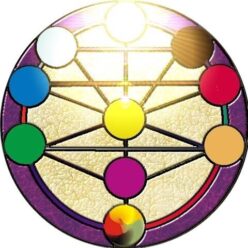Eremites or 'the Hermit'
Eremite (plural eremites) or Hermit; a religious recluse, someone who lives alone. A hermit (adjectival form: eremitic or hermitic) is a person who lives, to some degree, in seclusion from society. In Christianity, the term was originally applied to a Christian who lives the eremitic life out of a religious conviction, namely the Desert Theology of the Old Testament (i.e., the forty years wandering in the desert that was meant to bring about a change of heart). In the Magdeline mysteries, Mary was said to have retired to the desert following her katharsis and after Jesus’ crucifixion.
In the Christian tradition the eremitic life is an early form of monastic living that preceded the monastic life in the cenobium.
Etymology
The word hermit comes from the Latin ĕrēmīta,the latinisation of the Greek (erēmitēs), “of the desert”, which in turn comes from (erēmos), signifying “desert”, “uninhabited”, hence “desert-dweller”; adjective: “eremitic”.
Christianity
Because the life of the Christian hermit, both in ancient and in modern times, is rooted in the Desert Theology of the Old Testament, it is a life entirely given to the praise of God and the love and, through the hermit’s penance and prayers, also the service of all humanity. The latter is crucial to the correct understanding of the eremitic vocation, since the Judeo-Christian tradition holds that God created man (i.e., the individual human being) relational, which means that solitude can never be the purpose of any Christian vocation but only a conducive environment for striving after a particular spiritual purpose that forms part of our common human vocation.
Anchorite
The term “anchorite” (from the Greek anachōreō, signifying “to withdraw”, “to depart into the country outside the circumvallate city”) is often used as a synonym for hermit, not only in the earliest written sources but throughout the centuries. Yet the anchoritic life, while similar to the eremitic life, can also be distinct from it. In the Middle Ages anchorite was a common vocation. Anchorites and anchoresses lived the religious life in the solitude of an “anchorhold” (or “anchorage”), usually a small hut or “cell” built against a church. The door of anchorages tended to be bricked up in a special ceremony conducted by the local bishop after the anchorite had moved in. Medieval churches survive that have a tiny window (“squint”) built into the shared wall near the sanctuary to allow the anchorite to participate in the liturgy by listening to the service and to receive Holy communion. Another window led out into the street or cemetery, enabling charitable neighbours to deliver food and other necessities. Clients seeking the anchorite’s advice might also use this window to consult him or her. In our times the anchoritic life as a distinct form of vocation is almost unheard of.
New personal version
Eremite (the plural of Eremite is Eremites) or Hermit refers to a religious recluse or someone who lives alone. A Hermit is someone who lives in seclusion. In Christianity the term was applied to a Christian who lives the solitary life out of religious devotion; most particularly applied to the Desert Theology of the Old testament, which corresponds to the 40 years spent wandering the Desert which brings about a Mystical Transformation. In the Magdeline Mysteries, Mary was said to have retired to the desert following her Katharsis and after Jesus’ crucifixion.
Etymology
The word comes to us as a latinization of the Greek word eremite, meaning ‘desert’, ‘uninhabited’ and thence referring to a dweller of the desert. Describing someone like this would be ‘eremitic’ which came to be hermitic.
Christianity
Some claim that the Christian Life is rooted in the Desert Theology of the Old Testament (while others claim differently). In such a case, the Christian Life is entirely given to Devotion, Praise, Contemplation and Love of God; typified by penance, gratitude, prayers, and Service. The life of hermitage removes the devotee from the mundane pursuit of business and social responsibility, for the purpose of nurturing the Spiritual.
Anchorite
A similar term is Anchorite, from the Greek word meaning ‘to withdraw’ or ‘depart for the countryside’. In the middle ages, the anchorite would often live in a small hut affixed to a wall of the church. After moving in, the door was bricked over and the anchorite was imprisoned inside, with only a couple of small windows for receiving food from charitable parishioners and for his followers to get advice from him.
Today
While remaining metaphorical adjectives to describe persons of social reclusiveness and oddity, the Hermitic devotee has many more options in the modern world and will proceed according to his conscience and the Holy Spirit with the above mentioned traditions guiding him only as metaphors, which he is free to expand or transform in the exploration of mystical devotion and its daily application. Many artists and sedakas prefer a hermitic condition, at least during the initial stages of their practice in order to develop and consolidate their Spirituality. At some point the Hermit may emerge and proceed on a mission, prophetic or otherwise, directed by the Holy Spirit in Service to God or his Kingdom.
